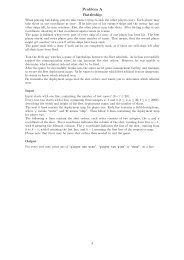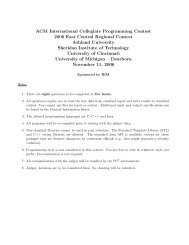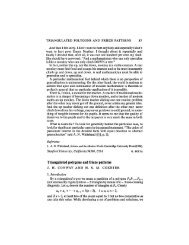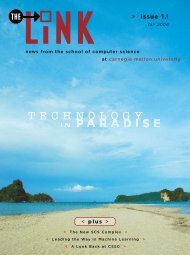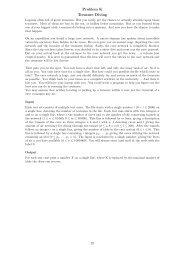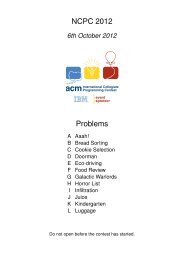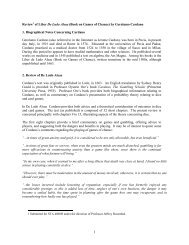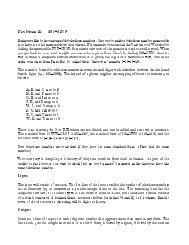Download now (1.3MB, PDF reader required) - Link home page
Download now (1.3MB, PDF reader required) - Link home page
Download now (1.3MB, PDF reader required) - Link home page
You also want an ePaper? Increase the reach of your titles
YUMPU automatically turns print PDFs into web optimized ePapers that Google loves.
ON CAMPUS<br />
All in good time<br />
Traffic-sensitive signals developed at the Robotics Institute<br />
are saving fuel, time and drivers’ nerves<br />
by linda k. schmitmeyer<br />
Gregory Barlow k<strong>now</strong>s a lot about traffic, and not just how<br />
long it takes to commute from his <strong>home</strong> in Squirrel Hill<br />
to his office in Newell-Simon Hall, where he works with<br />
CMU research professor Stephen Smith on tackling traffic<br />
congestion in urban areas.<br />
Barlow (CS’11), a post-doctoral researcher in<br />
the Robotics Institute, k<strong>now</strong>s traffic problems<br />
are nothing new: The early Romans wrestled<br />
with them two millennia ago by banning<br />
wagons on their roads during certain times<br />
of the day. He also k<strong>now</strong>s they’re costly: In<br />
2009, drivers in 439 urban areas in the United<br />
States traveled 4.8 billion hours longer and<br />
purchased 3.9 billion more gallons of fuel<br />
because of traffic snarls, for a total congestion<br />
cost of $115 billion.<br />
And all this comes from Barlow, a man who admits,<br />
“I don’t really like to drive.”<br />
Maybe that’s why he’s working to improve the driving<br />
experience in Pittsburgh, along with CMU colleagues<br />
Xiao-Feng Xie, a research associate, and Zachary B.<br />
Rubinstein, a senior systems scientist. They are part of a<br />
team led by Smith, director of the Intelligent Coordination<br />
and Logistics Laboratory in the Robotics Institute, where<br />
they developed a “smart” traffic signal that works in realtime.<br />
Smith has dubbed the project Scalable Urban Traffic<br />
Control (SURTRAC).<br />
Today, most signals operate by pre-setting the timing on<br />
the green light for several different periods throughout<br />
the day, depending on the number of vehicles expected<br />
to travel through an intersection. As part of the Traffic21<br />
Initiative in Carnegie Mellon’s H. John Heinz III College,<br />
the researchers developed software that allows a signal<br />
to respond to traffic as it is happening. Last spring, they<br />
installed adaptive signaling systems at nine intersections<br />
in Pittsburgh’s East Liberty neighborhood.<br />
“Our system watches actual traffic flow through the<br />
cameras at each intersection and dynamically adjusts<br />
the green timing periods on a second-by-second basis,”<br />
Smith says.<br />
According to Smith, similar software is already being<br />
used to manage traffic flow onto along arterial roadways—<br />
surface roads with a strong traffic flow in one direction<br />
and some side streets. With these systems, though,<br />
information is typically collected and sent to a central<br />
location, where data are analyzed and adjustments to the<br />
signaling are determined.<br />
“It can take anywhere from five to 15 minutes<br />
(to reprogram the signals), depending on<br />
the system being used,” Smith says.<br />
“The beauty of our approach is that it is<br />
decentralized, which makes it inherently<br />
scalable, in principle.”<br />
There also are decentralized systems used on<br />
arterial roads, says Smith, but they operate on<br />
the assumption that there is a dominant flow<br />
of traffic that does not change.<br />
SURTRAC, in contrast, is designed to discover the<br />
dominant flow of vehicles through an intersection and<br />
automatically adjust the signaling. It is designed to operate<br />
within urban grids, where the volume and direction of<br />
traffic can change throughout the day.<br />
At the East Liberty intersections, cameras take continuous<br />
shots of the traffic, which allows SURTRAC to create a<br />
schedule for moving vehicles through the intersections<br />
in the most efficient way possible. Each intersection also<br />
communicates via a fiber optic cable (or, in the case of<br />
one East Liberty intersection, a wireless signal) to its<br />
downstream neighbors as to what the projected outflow<br />
from its signal will be. The neighboring signals do the same<br />
thing, and together they create a communications network<br />
that’s akin to having the watchful eyes of traffic police at<br />
every intersection.<br />
More impressive, though, are the net results. At the East<br />
Liberty intersections, the research team found that the<br />
wait time for people driving through the grid was reduced<br />
by 40 percent. Travel time was reduced by 26 percent and<br />
projected vehicle emission by 21 percent. The researchers<br />
obtained the results by completing “before” and “after”<br />
drives along 12 predetermined routes through the nine<br />
intersections. They did the drives during four set times<br />
throughout the day; GPS tracers on their cell phones<br />
4





